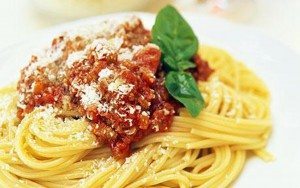Bolognese sauce, eaten with spaghetti, is an Italian meat-based sauce or ragù, which is said to come from Bologna,that wonderful city of food located in Emilia Romagna. Curiously, spaghetti Bolognese is very popular outside of Italy, but is said to have never existed in Bologna itself, where meat-based ragù was always served with the local egg pastas tagliatelle or lasagne. Spaghetti bolognese, on the other hand, is usually eaten with a wheat pasta. There are several options, however, including non-wheat, gluten-free pastas, such as buckwheat pasta, brown rice pasta and a pasta made with corn meal and quinoa.
There are differing opinions as to how Bolognese became so very popular outside of Italy before it was introduced to Italians. Some believe American GIs imported the idea of eating meat ragù in Italy to America after World War II, where many Italian-American chefs served it on spaghetti rather than local egg pastas for returning GIs.
When the war ended, it’s possible that American and British soldiers who returned to Italy as tourists asked for spaghetti bolognese from the local chefs who gave it to them, even though it was a foreign dish from America and Britain. Former soldiers came back to the U.S. with even more zest for the dish. Thus, a meat ragù dish, created by American chefs with spaghetti, became popularized in Italy by their Italian counterparts, leading to an even greater popularity in the United States and Britain. The accuracy of this story is less important than the enjoyment of considering the delicious consequences—a dish that survived World War II to become one of our favorite meals.
This reminds me of another story told mostly by my Italian-American friends. The story goes that the French learned about their own “true cuisine” from the Italian influence brought to France by the arranged marriage of an Italian bride in the 16th century. Her name was Catherine de Medici, an Italian noblewoman who became Queen of France from 1547 until 1559, as the wife of the French monarch, King Henry II. She also bore three young men with King Henry, who were naturally both of French and Italian heritage. The most important aspect of the story is that the cross fertilization of Italian and French cuisine benefited everyone, no matter where they were born. In a similar vein, spaghetti bolognese became a dish of enormous popularity, no matter who invented it.
I enjoy bolognese even more than spaghetti and meatballs. Well, at least as much, if not more. Of course, the better the meatballs, the better the dish. I enjoy preparing my meatballs with equal parts of ground beef, pork and veal. Then I like to add chopped onions, garlic, grated Parmigiana Reggiano, chopped flat leaf parsley and some sea salt, ground pepper, and a few fresh, finely chopped thyme and marjoram leaves. I enjoy making these meatballs on the small side, like a golf ball—browned in a skillet and then added to a homemade marinara, where they simmer for at least an hour or two with a medium-size pork bone, ideally smoked on the grill. Makes your mouth water, doesn’t it?
Bolognese, on the other hand, is not made into balls. Instead, all ingredients are browned together in a large skillet. Both meatballs and bolognese are delicious. Bolognese takes longer to prepare, but it’s worth it. As an added treat, your guests can enjoy some homemade garlic bread toasted with some finely diced garlic, a pinch of salt and ¼ cup extra-virgin olive oil heated together for a few minutes. A green salad tossed with lemon juice and a dash of olive oil is also nice complement to spaghetti bolognese.
Spaghetti Bolognese
Serves 4 to 6
1 tbsp olive oil
4 oz bacon or pancetta, diced
1½ cups yellow onions, chopped
1 cup carrots, finely diced
½ cup celery, finely diced
1 tbsp garlic, minced
1 tsp kosher salt
½ tsp ground black pepper
2 bay leaves
Pinch of saffron
¼ cup fresh basil leaves, chopped
2 tsp dried thyme
1 tsp dried oregano
1 tsp marjoram
1 tsp ground cinnamon
1 tsp ground nutmeg
1½ lb 80 percent ground beef
1 lb pork sausage,
removed from its casing
4 tbsp tomato paste
1 cup red wine
2 28-oz cans plum tomatoes with juice (ideally, Marzano brand)
1 cup chicken broth
¼ cup heavy cream
2 tbsp unsalted butter
3 tbsp fresh Italian parsley, chopped
2 lb spaghetti, domestic Ronzoni or imported De Cecco brands
1 cup freshly grated Parmesan
1. In a large pot, heat the oil over medium-high heat. Add the bacon and cook, stirring until browned and the fat is rendered for 4 to 5 minutes.
2. Add the onions, carrots and celery and cook, stirring until soft for 4 to 5 minutes. Add the garlic, salt, pepper, bay leaves, saffron, basil, thyme, oregano, marjoram, cinnamon, nutmeg and cook, stirring for 30 seconds. Add the beef and sausage, and cook, stirring until no longer pink, about 5 minutes.
3. Add 2 tablespoons of the tomato paste and cook, stirring for 3 to 5 minutes. Add wine and cook, stirring, to deglaze the pan and remove any browned bits sticking to the bottom of the pan, until half of the liquid is reduced, about 2 minutes.
4. Add the plum tomatoes with their juices, the remaining tomato paste and chicken broth and bring to a boil. Reduce heat to medium-low and simmer, stirring occasionally to prevent sauce from sticking to the bottom of the pan, until thickened and flavorful, about 1½ hours.
5. Add cream, butter and parsley, and stir well; simmer for 2 minutes. Adjust the seasoning, to taste. Remove from heat and cover to keep warm until ready to serve.
6. Meanwhile, bring 4 quarts of salted water in a large soup pot to a boil. Add the pasta and return the water to a low boil. Cook, stirring occasionally to prevent the noodles from sticking, until al dente, 8 to 10 minutes. Drain in a colander.
Please send comments, questions or observations of interest to Chef Alan at [email protected].



